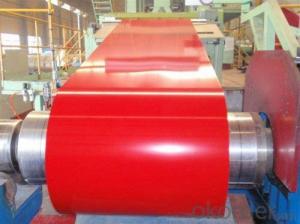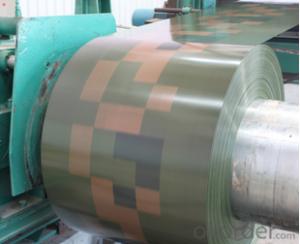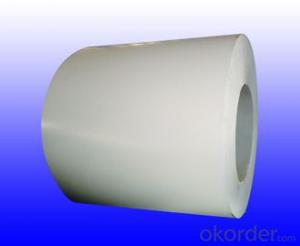Crystal Red Highlights PPGI/Pre-painted Hot Dipped Galvanized Steel Coil /Sheet/Aluminized plate
- Loading Port:
- Tianjin
- Payment Terms:
- TT OR LC
- Min Order Qty:
- 25 m.t.
- Supply Capability:
- 50000 m.t./month
OKorder Service Pledge
OKorder Financial Service
You Might Also Like
Specification
1.Crystal Red Highlights ppgi/Pre-painted Hot Dipped Galvanized Steel Coil Features:
. A strong anti-corrosion properties, good corrosion resistance. The use of hot dipped galvanized steel substrates for the Color Painted steel coil, with the exception of zinc have anti-corrosion layer, a layer of coatings have seized coverage and protection, allowing effective anti-rust products, galvanized coil about life than double.
. A good cold-formed molding processing, users can directly processed into finished products. Substituting wood to steel, easy to transport, and efficient construction, energy conservation.
2.Applications of Crystal Red Highlights ppgi/Pre-painted Hot Dipped Galvanized Steel Coil
.Used as roof panel, wall panel in steel structure in warehouse, factories exhibition hall container houses, cold storage
.It is also mainly used in light industry, automobile, construction, animal husbandry, fishery and commerce, etc,
3.Product Introduction information:
| PRODUCT | Crystal Red Highlights ppgi/Pre-painted Hot Dipped Galvanized Steel Coil |
| STANDARD | GB/T-12754: 2006, JIS330, ASTM A653, JIS G330, GB/T2518, ASTM A792, JIS G3321, JIS G3317 |
| BASE METAL | Hot dipped Galvanized steel sheet/coil, Hot dipped Galvalume steel sheet/coil |
| EQUIPMENT | Double coating double baking; three coating three painting |
| SUPPLY CAPACITY | 500,000 Tons per Year |
| SIZE | Thickness: 0.3mm-1.0 mm,thickness tolerance: +/- 0.02mm Width : 700mm—1250mm |
| ZINC COATING | 30g/m2-150g/m2 |
| PAINT THICKNESS | Top Side: 10-25 microns; Back Side: 4-8 microns |
| COIL WGT | Normally 5 Tons per Coil, aslo as required by customer |
| COIL ID | 508mm/610mm |
| SURFACE PAINT | EP, PE, HDP, SMP, PVDF |
4.Crystal Red Highlights ppgi/Pre-painted Hot Dipped Galvanized Steel Coil image:




5.FAQ
We have organized several common questions for our clients,may help you sincerely:
①How about your Warranty?
Warranty: 1-Year for the whole light. Warranty is based on correct storage, installation, using and maintenanc
②How to guarantee the quality of the products?
We have established the international advanced quality management system,every link from raw material to final product we have strict quality test;We resolutely put an end to unqualified products flowing into the market. At the same time, we will provide necessary follow-up service assurance.
③How long can we receive the product after purchase?
In the purchase of product within three working days, We will arrange the factory delivery as soon as possible. The pecific time of receiving is related to the state and position of customers.Commonly 7 to 10 working days can be served.
- Q: What is the role of steel coils in the manufacturing of agricultural machinery?
- Steel coils play a crucial role in the manufacturing of agricultural machinery as they are used to fabricate various components and parts such as frames, chassis, blades, and implements. The high strength and durability of steel make it an ideal material for withstanding the harsh conditions and heavy-duty applications that agricultural machinery often faces. Additionally, the versatility of steel coils allows manufacturers to customize and shape them into different forms and sizes, ensuring the production of reliable and efficient agricultural machinery.
- Q: i mean cor ten steel( rusted)
- If the steel is true Cor Ten steel, it does not require waxing. Cor Ten is a steel designed to rust slowly over time ... then the rust acts as a natural barrier to prevent further rust. Check out the United States Steel building in downtown Pittsburgh, PA ... its nickname is The Rusty Nail.
- Q: I want to buy steel. My problem is i purchase it from a middle man, so i need to know what MIld steel is. What it's real name or specifications is/are. I dont want to end up purchasing Black steel or other stuff i can sell or use...
- I am a Blacksmith,mild Steel is what I use every Day,I make Ornamental Ironworks,like Handrails,Gate,Candle holders,all kind of things,most things are made from mild Steel,even Buildings,Doors,and so on.No risk of buying it.Special Steel is just for Special Applications.
- Q: What are the main factors that affect the flatness of steel coils?
- The main factors that affect the flatness of steel coils include the quality and consistency of the incoming raw material, the precision of the rolling process, the tension applied during rolling, the cooling and annealing processes, and the handling and storage of the finished coils.
- Q: What is the difference between cold rolled strip and cold rolled steel coil?
- Single literal explanation, volume and band are different, appearance shape is not the same.
- Q: How are steel coils inspected for thickness using ultrasonic testing?
- Steel coils can be inspected for thickness using ultrasonic testing, which is a non-destructive testing method. In this process, a handheld ultrasonic thickness gauge is used to measure the thickness of the steel coil. The ultrasonic thickness gauge emits high-frequency sound waves that travel through the steel coil. These sound waves bounce back from the backside of the coil, creating an echo. The time taken for the echo to return to the gauge is measured and used to calculate the thickness of the coil. The gauge consists of a transducer that emits the sound waves and a receiver that detects the echoes. The transducer is placed on the surface of the coil, and a coupling gel or oil is used to ensure a good acoustic contact between the transducer and the steel surface. The transducer emits a short burst of sound waves, which penetrates through the steel coil and reaches the backside. When the sound waves encounter any changes in the thickness of the coil, such as defects or variations, they get reflected back to the transducer. The receiver detects these echoes, and the time between the emission and reception of the sound waves is measured. Using the known speed of sound in steel, the time taken for the sound waves to travel through the coil and back can be converted into a thickness measurement. This provides an accurate assessment of the thickness of the steel coil at various points. Ultrasonic testing is a reliable and efficient method for inspecting the thickness of steel coils. It allows for quick measurements without damaging the material, making it suitable for quality control and ensuring compliance with manufacturing specifications.
- Q: How are steel coils straightened?
- Steel coils are straightened using a process called leveling. This involves passing the coils through a series of rollers that gradually flatten and align the steel, resulting in straightened coils.
- Q: How are steel coils used in the manufacturing of industrial valves?
- Steel coils are used in the manufacturing of industrial valves as they provide the necessary raw material for creating valve bodies, stems, and other components. The coils are shaped, cut, and formed into different valve parts, ensuring strength and durability. These steel components are then assembled, welded, and machined to create fully functional industrial valves used in various applications such as oil and gas, chemical processing, and water treatment industries.
- Q: I have a tiara and it oxidized and I'm not sure what material it is. I know it it isn't metal so i was wondering if is steel? Also if it's steel, can I do something to clean it?
- Yes - Steel can oxidize, its most commonly called rust Steel is a metal. Depending on the level of oxidation, you might be able to polish it with very fine steel wool. If is is really bad, then you might need a chemical cleaner such as Naval Jelly, which can be found at the hardware store. But the Naval Jelly might discolor the metal, so then you might need to polish it afterward to return its finish.
- Q: How are steel coils tested for dimensional accuracy?
- Steel coils are tested for dimensional accuracy using various methods such as measuring the width, thickness, and length of the coils. This can be done through manual measurement using measuring tapes or calipers, or with the help of advanced technologies like laser-based sensors or non-contact measurement systems.
Send your message to us
Crystal Red Highlights PPGI/Pre-painted Hot Dipped Galvanized Steel Coil /Sheet/Aluminized plate
- Loading Port:
- Tianjin
- Payment Terms:
- TT OR LC
- Min Order Qty:
- 25 m.t.
- Supply Capability:
- 50000 m.t./month
OKorder Service Pledge
OKorder Financial Service
Similar products
Hot products
Hot Searches
Related keywords




























